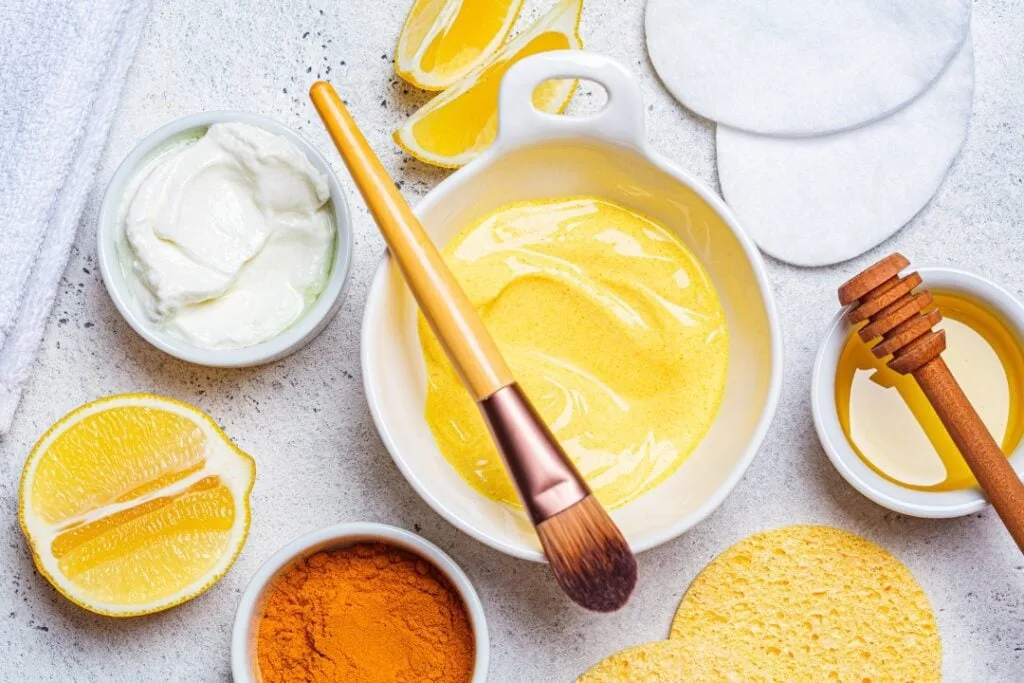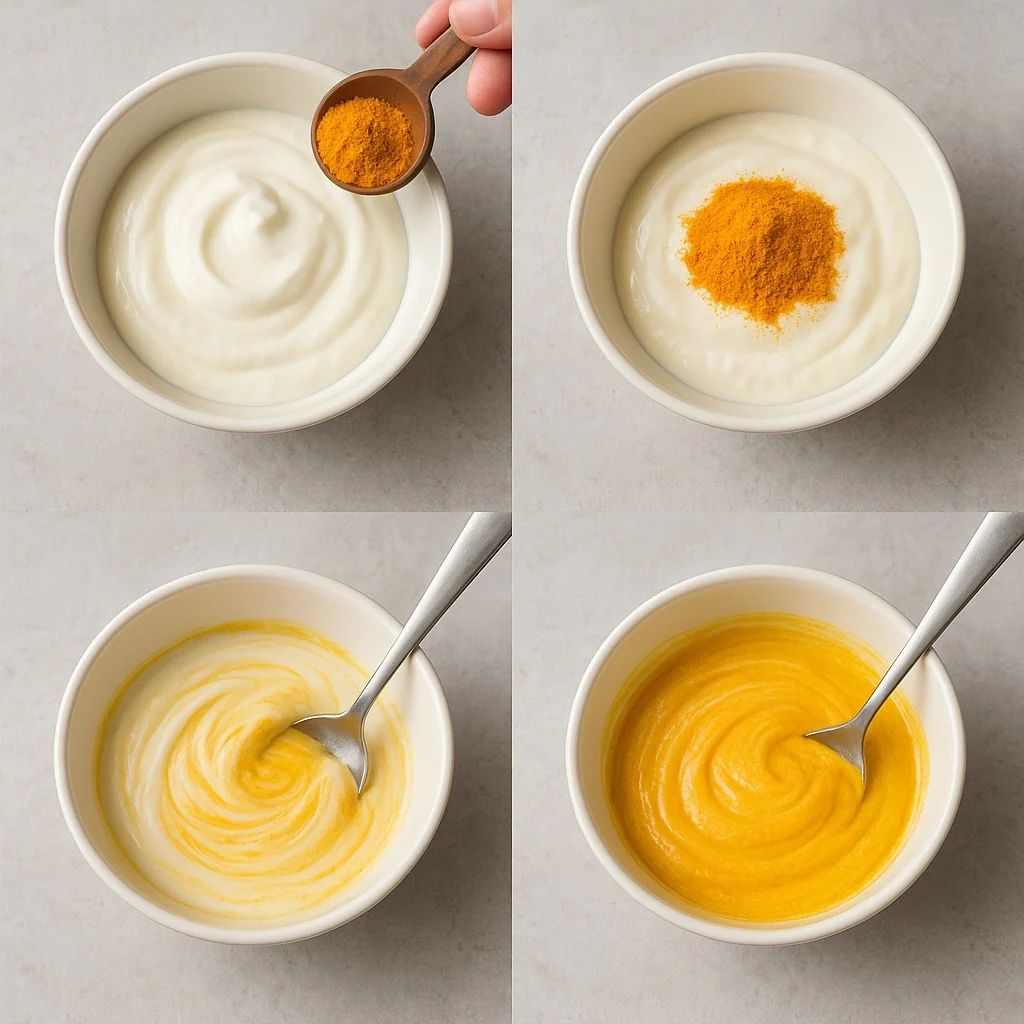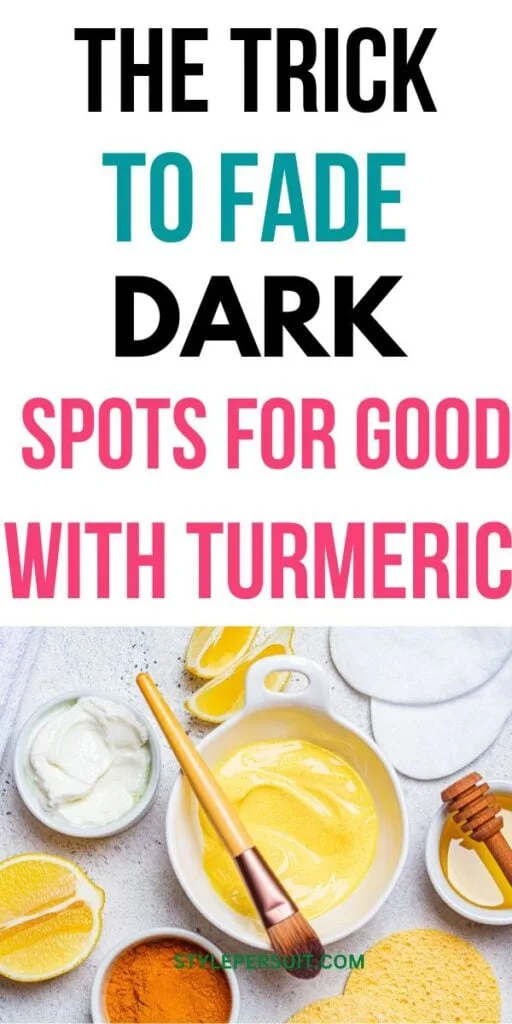Dark spots are stubborn, aren’t they? One day, your skin is clear, the next you notice a patch hanging around like an uninvited guest.
Sun exposure, acne scars, and even the natural process of aging can leave marks that make your complexion look uneven.
And while the beauty aisle is filled with serums and creams promising miracles, sometimes the solution is sitting quietly in your spice rack.
That bright golden powder you sprinkle in curries, turmeric, has been used for centuries in Ayurvedic and natural beauty traditions.
Women across India, the Middle East, and parts of Africa have relied on turmeric pastes to brighten skin before weddings, soothe blemishes, and even out tone.
Now, it’s trending again, only this time on TikTok and Pinterest as a DIY homemade face mask for dark spots.
But does it work? Let’s unpack it.

Why Turmeric Is a Secret Weapon for Skin
The star inside turmeric is curcumin, a compound that’s been studied for its antioxidant and anti-inflammatory properties. When applied to skin, it does a few key things:
- Helps fade dark spots and hyperpigmentation – turmeric slows down melanin production, which causes patches to appear darker.
- Soothes acne and blemishes – thanks to antibacterial properties, it calms breakouts.
- Gives that natural glow – turmeric face masks are known for leaving skin bright and refreshed, especially when combined with yogurt or honey.
So if you’re searching for a turmeric face mask for hyperpigmentation, a turmeric face mask for blemishes, or even the best turmeric face mask lightener, you’re in the right place.
It won’t bleach your skin or work overnight, but consistent use can visibly reduce spots and make your skin look more even.
Things to Know Before Smearing It On
Like any natural remedy, turmeric comes with quirks. A few tips to avoid “oops” moments:
- Staining is real. Turmeric can leave a yellow tint on lighter skin. Keeping masks thin and mixing with yogurt, milk, or aloe reduces this. If it does stain, a little baking soda paste or micellar water takes care of it.
- Patch test first. Everyone’s skin reacts differently. Try a small amount on your jawline before applying all over.
- Don’t overdo it. Two to three times a week is plenty. More can dry your skin.
- Use applicators. To keep your hands from turning gold, use a silicone face mask brush (see options here). They’re reusable, easy to clean, and save your nails from staining.
- Have cloths handy. A set of bamboo face cloths (like these) makes clean-up much easier.
And if you’re worried about messing up your bathroom sink? A quick scrub with lemon and baking soda usually lifts turmeric stains.
Setting the Stage: Products That Pair Well With Turmeric Masks
While turmeric does the heavy lifting, pairing it with the right skincare basics makes results faster and longer-lasting. Here are a few helpers worth having:
- A gentle daily cleanser to prep your skin before masks (browse options).
- A lightweight face moisturizer to lock in hydration after masking (see choices here).
- For extra glow, some people layer turmeric masks with a Vitamin C serum on alternate days (explore here).
Think of turmeric as the star, but these products are the backup dancers keeping your routine balanced.
Core Turmeric Face Mask Recipes
These are the classic masks people swear by because they’re simple, inexpensive, and surprisingly effective.
Each one has a slightly different target: glow, acne, hydration, or exfoliation.
1. Yogurt + Turmeric: The Brightening Staple

This is probably the most shared turmeric face mask for hyperpigmentation on Pinterest.
Yogurt contains lactic acid, which gently exfoliates dead skin cells, while turmeric tackles uneven spots.
Together, they brighten and soften your complexion.
You’ll need:
- 1 teaspoon turmeric powder
- 2 tablespoons plain yogurt (unsweetened, no flavors)
- ½ teaspoon honey (optional, for extra hydration)
How to make it:
Stir until smooth, then spread a thin layer across clean skin using a mask brush (like these). Leave it for 10–15 minutes. Wash with lukewarm water, and finish with a lightweight moisturizer.
The texture is cooling, almost like a natural spa treatment. Use it 2–3 times a week for that subtle glow people often refer to as “lit from within.”
2. Honey + Turmeric: Hydration + Healing
Honey is a natural humectant, it draws moisture into the skin. Combined with turmeric, this becomes a great turmeric face mask for blemishes because it not only hydrates but also calms irritation and redness.
You’ll need:
- 1 teaspoon turmeric powder
- 1 tablespoon raw honey (manuka is ideal, but regular works too)
How to make it:
Blend the two until they form a sticky paste. Apply evenly and let sit for 15–20 minutes. Rinse with warm water, then gently pat your skin with a bamboo face towel (like this set).
This mask is especially good if your skin feels tight or irritated after breakouts. People often report seeing a glow even after the first application.
3. Aloe Vera + Turmeric: The Calming Cooler
If your skin is easily irritated or prone to redness, this recipe is for you. Aloe vera soothes and hydrates, while turmeric reduces inflammation.
Perfect for summer days or post-sun exposure.
You’ll need:
- 1 teaspoon turmeric
- 2 tablespoons aloe vera gel (fresh if possible, or bottled pure gel)
How to make it:
Mix into a smooth gel-like consistency. Apply generously, let it sit for 10–15 minutes, then rinse with cool water.
Pro tip: Keep a tube of organic aloe vera gel (see options) in your fridge. It feels incredibly refreshing when cold.
Some even use this combo as a turmeric mask for dark spots on knees or elbows, since aloe helps soften rough skin.
4. Lemon + Turmeric: The Brightness Booster
For those who want a stronger dark spot treatment with turmeric, adding lemon juice intensifies the brightening effect.
But caution: lemon can make your skin more sensitive to sunlight, so this is a nighttime mask.
You’ll need:
- 1 teaspoon turmeric
- 1 teaspoon fresh lemon juice
- 1 tablespoon yogurt or honey (to dilute the acidity)
How to make it:
Mix into a creamy blend, apply for 8–10 minutes (not longer), then rinse thoroughly. Always follow with a moisturizer and sunscreen the next day.
Pro tip: Pair this with a daily mineral sunscreen (browse options) if you’re outdoors regularly. It keeps your skin safe while the mask does its work.
5. Oatmeal + Turmeric: Gentle Exfoliation
Sometimes dark spots look darker simply because dead skin builds up around them. That’s where this DIY face mask for dark spots and texture comes in.
Oatmeal gently exfoliates, while turmeric calms.
You’ll need:
- 1 tablespoon finely ground oatmeal
- 1 teaspoon turmeric powder
- 1 tablespoon milk or yogurt
How to make it:
Blend into a paste. Apply while gently massaging in circles for a minute. Leave on for 10–15 minutes, then rinse with circular motions.
This mask doubles as a DIY face mask for glowing skin because it polishes and nourishes at the same time.
Using a gentle exfoliating scrub pad (like these) can help remove the mask cleanly without tugging.
More Recipes + Beyond the Face
By now, you’ve seen how versatile turmeric can be. But we’re not done yet. Here are more masks that tackle everything from acne scars to dry patches, plus a few ideas for dark spots outside the face.
6. Rice Flour + Turmeric: Oil Control + Matte Finish
Rice flour is one of those underrated ingredients. It mattifies oily skin, gently exfoliates, and brightens at the same time.
Mixed with turmeric, it’s a powerhouse against acne scars and pigmentation.
You’ll need:
- 1 teaspoon turmeric
- 1 tablespoon rice flour
- 2 tablespoons milk (or rose water for extra freshness)
How to make it:
Blend until it forms a smooth paste. Apply evenly and let it dry for 15 minutes. Rinse with lukewarm water while gently scrubbing in circles.
This works beautifully as a turmeric face mask recipe for acne because it not only calms breakouts but also absorbs excess oil.
To keep it tidy, grab a mask mixing bowl + brush set (see here).
7. Coconut Oil + Turmeric: Dry Skin Savior
If your skin feels flaky, this is your best bet. Coconut oil deeply nourishes, while turmeric evens out spots—ideal for winter or dry climates.
You’ll need:
- 1 teaspoon turmeric
- 1 tablespoon coconut oil (virgin, cold-pressed preferred)
How to make it:
Stir into a golden balm and massage gently into your skin. Leave for 15 minutes, then rinse with warm water. You may need a mild cleanser afterward if coconut oil feels heavy.
This doubles as a DIY homemade facial mask with turmeric that hydrates while treating pigmentation.
Stock up on organic coconut oil (like this one) and you’ll find dozens of uses beyond skincare.
8. Apple Cider Vinegar + Turmeric: Spot Target
This one’s a little more intense and works best as a spot treatment, not a full-face mask. ACV balances pH, gently exfoliates, and turmeric targets dark marks.
You’ll need:
- ½ teaspoon turmeric
- ½ teaspoon apple cider vinegar
- A drop of honey (to soften the formula)
How to make it:
Mix into a paste and dab directly on dark spots or blemishes with a cotton swab. Leave for 5–8 minutes max, then rinse.
Keep a bottle of raw apple cider vinegar (here) on hand—it’s useful for skin, hair rinses, and even gut health.
9. Fuller’s Earth (Multani Mitti) + Turmeric: Acne Defense
Popular in South Asian beauty routines, Fuller’s Earth (or Multani Mitti) is a clay that absorbs oil and clears clogged pores.
Paired with turmeric, it’s excellent for acne-prone skin and post-pimple marks.
You’ll need:
- 1 teaspoon turmeric
- 2 tablespoons Multani Mitti clay
- Enough rose water to form a paste
How to make it:
Mix everything until smooth. Apply and let it dry for 15–20 minutes before rinsing. Follow with moisturizer to avoid dryness.
You can buy Multani Mitti clay powder online (see options), and it lasts forever since you only need a little each time.
10. Overnight Turmeric Spot Treatment
Sometimes, you don’t need a full mask you just want that one stubborn spot to fade. This overnight dab treatment is your friend.
You’ll need:
- ½ teaspoon turmeric
- A few drops of milk or aloe vera gel
How to make it:
Mix into a thick paste, dab onto dark spots with a cotton bud, and leave overnight. Rinse thoroughly in the morning.
It’s one of the simplest DIY face mask dark spot hacks out there. Keep a set of reusable cotton swabs (see here) handy to avoid stains on your fingers.
Turmeric Beyond the Face: Knees, Elbows & Underarms
Dark spots don’t just show up on the face. Many people deal with pigmentation on their knees, elbows, and even underarms. Turmeric can help here, too.
- For knees and elbows: Try the oatmeal + turmeric mask or rice flour + turmeric mask they exfoliate and brighten rough patches.
- For underarms: Use the aloe vera + turmeric mask, since underarm skin is delicate and prone to irritation.
Apply 2–3 times a week and moisturize afterward with a natural shea butter lotion (like this one) to prevent dryness.
Lifestyle Habits That Boost Turmeric’s Results
- Sunscreen is non-negotiable.
UV exposure is one of the biggest triggers for hyperpigmentation. Even the best turmeric face mask lightener won’t work if you skip SPF. Try a lightweight mineral sunscreen (browse options here). - Hydration keeps skin even-toned.
Drinking enough water sounds cliché, but dehydration makes skin look duller and spots more noticeable. Pair masks with a hydrating routine — moisturizers, facial mists, and water-rich foods. - Exfoliate gently.
A mild exfoliant once or twice a week helps dead skin cells slough away, letting turmeric penetrate better. You don’t need anything harsh — a gentle exfoliating scrub (see here) will do. - Consistency beats intensity.
A mask once every two weeks won’t cut it. Two or three times weekly, combined with smart skincare, delivers visible results in a month or two.
FAQs About Turmeric for Dark Spots
Does turmeric really lighten dark spots?
Yes, turmeric reduces melanin production over time, making spots less visible. Think weeks of consistent use, not overnight miracles.
Can turmeric bleach skin?
No, it doesn’t bleach. It gradually balances tone, which is why it’s safe for regular use.
How long does it take to see results?
Most people notice subtle changes in 3–4 weeks, with bigger improvements after 8–12 weeks.
Can turmeric help melasma?
It may soften melasma patches, but results vary. Pairing turmeric masks with a dermatologist-approved treatment often gives better outcomes.
Does turmeric stain skin?
Sometimes. Mixing with yogurt, aloe, or honey helps reduce staining. If you get a yellow tint, use micellar water or a facial cleansing oil (see options).
A Little More Than Skin Deep
Here’s the thing: sometimes the value of a turmeric mask isn’t just about fading a spot. It’s about the ritual.
The small act of mixing golden powder with honey, the earthy smell that clings to your fingers, the cool spread across your cheeks, it’s grounding.
We live in a rush-rush routine, and setting aside 15 minutes for a DIY face mask for glowing skin is, in a way, a reminder that caring for yourself doesn’t always require a spa day or a $200 serum.
Sometimes, it’s just you, your kitchen, and a little golden spice that’s been trusted for generations.
Related Reads You’ll Love
To build a full routine, check out these posts too:
- Best Natural Dark Spots Remedies That Really Work — more treatments that pair well with turmeric.
- Teeth Whitening at Home: How to Whiten Teeth Naturally — if you’re into DIY beauty, this guide will interest you.
Each one deepens your journey into safe, natural skincare.
Final Takeaway
Turmeric isn’t a trend, it’s a tradition. Whether you’re battling acne scars, sun damage, or uneven tone, a simple DIY homemade face mask with turmeric can help.
From yogurt blends for glow to rice flour masks for oil control, these recipes work because they’re gentle, natural, and time-tested.
Will it erase every spot instantly? No. But give it time, be consistent, and you’ll see why turmeric has been a beauty staple for centuries.
And maybe, just maybe, you’ll find that the ritual itself is as healing as the results.

